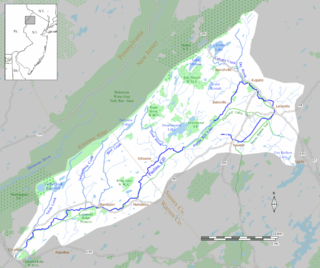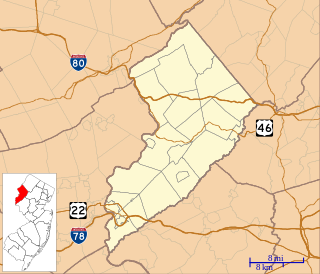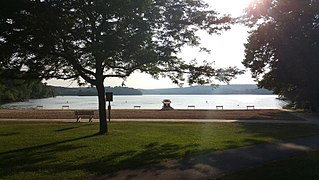| Wallpack Ridge | |
|---|---|
| Walpack Ridge | |
Wallpack Ridge seen from Mountain Road | |
| Highest point | |
| Elevation | 928 ft (283 m) |
| Coordinates | 41°8′7.649″N74°54′34.65″W / 41.13545806°N 74.9096250°W |
| Geography | |
| Range coordinates | 41°14′1.234″N74°51′10.147″W / 41.23367611°N 74.85281861°W Coordinates: 41°14′1.234″N74°51′10.147″W / 41.23367611°N 74.85281861°W |
| Parent range | Kittatinny Mountain |
| Geology | |
| Age of rock | Late Silurian |
| Mountain type | Dendritic ridge |
| Climbing | |
| Access | Restricted access roads |
Wallpack Ridge (or Walpack Ridge) is a mountain located in the Ridge and Valley Appalachians physiographic province in Sussex County in northwestern New Jersey. Oriented northeast to southwest, Wallpack Ridge spans 25 miles (40 km) from Montague Township south of Port Jervis, New York to the Walpack Bend in the Delaware River near Flatbrookville in Walpack Township. It is a narrow ridge ranging between 0.67 miles (1.08 km) to 1.7 miles (2.7 km) in width, and its highest elevation reaches 928 feet (283 m) above sea level. [1] The ridge separates the Wallpack Valley from the valley of the Delaware River (also known as the Minisink or Minisink Valley), and contains the watershed of the Flat Brook and its main tributaries Big Flat Brook and Little Flat Brook. [2]
A physiographic province is a geographic region with a characteristic geomorphology, and often specific subsurface rock type or structural elements.

Sussex County is the northernmost county in the State of New Jersey. Its county seat is Newton. It is part of the New York Metropolitan Area and is part of the state's Skylands Region, a term promoted by the New Jersey Commerce, Economic Growth, & Tourism Commission to encourage tourism. As of the 2017 Census estimate, the county's population was 141,682, making it the 17th-most populous of the state's 21 counties, a 5.1% decrease from the 149,265 enumerated in the 2010 United States Census, in turn an increase of 5,099 (3.5%) over the 144,166 persons enumerated in the 2000 Census. Based on 2010 Census data, Vernon Township was the county's largest in both population and area, with a population of 23,943 and covering an area of 70.59 square miles (182.8 km2).

New Jersey is a state in the Mid-Atlantic and Northeastern regions of the United States. It is located on a peninsula, bordered on the north and east by the state of New York, particularly along the extent of the length of New York City on its western edge; on the east, southeast, and south by the Atlantic Ocean; on the west by the Delaware River and Pennsylvania; and on the southwest by the Delaware Bay and Delaware. New Jersey is the fourth-smallest state by area but the 11th-most populous, with 9 million residents as of 2017, and the most densely populated of the 50 U.S. states; its biggest city is Newark. New Jersey lies completely within the combined statistical areas of New York City and Philadelphia. New Jersey was the second-wealthiest U.S. state by median household income as of 2017.
A controversial project to build a hydroelectric dam and reservoir on the Delaware River in the 1950s and 1960s led to government's seizure of land in northwestern New Jersey and northeastern Pennsylvania under the authority of the U.S. Army Corps of Engineers. The construction of the dam would have created a lake reservoir that would have flooded the Walpack Valley. For political and geological reasons, the dam project was deauthorized and the land transferred to the management of the National Park Service for the establishment of a National Recreation Area. [3] Currently, Wallpack Ridge is located in the Delaware Water Gap National Recreation Area that was established by the National Park Service in 1978.

The National Park Service (NPS) is an agency of the United States federal government that manages all national parks, many national monuments, and other conservation and historical properties with various title designations. It was created on August 25, 1916, by Congress through the National Park Service Organic Act and is an agency of the United States Department of the Interior. The NPS is charged with a dual role of preserving the ecological and historical integrity of the places entrusted to its management, while also making them available and accessible for public use and enjoyment.

A National Recreation Area (NRA) is a designation for a protected area in the United States.

The Delaware Water Gap National Recreation Area is a 70,000 acres (28,000 ha) protected area designated a National Recreation Area administered by the U.S. Department of the Interior's National Park Service. It is located along the middle section of the Delaware River in New Jersey and Pennsylvania stretching from the Delaware Water Gap northward in New Jersey to the state line near Port Jervis, New York, and in Pennsylvania to the outskirts of Milford. A 40-mile (64 km) section of the Delaware River, entirely within the National Recreation Area, has been granted protected status as the Middle Delaware National Scenic River under the National Wild and Scenic Rivers System and is also administered by the National Park Service. This section of the river is the core of the historical Minisink region.












